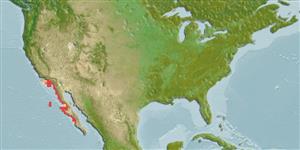Gastropoda |
Lepetellida |
Haliotidae
Environment: milieu / climate zone / depth range / distribution range
Ecology
Benthic; depth range 0 - 18 m (Ref. 865). Subtropical; 34°N - 24°N, 120°W - 111°W
Eastern Pacific: USA to Mexico. Ranges from Point Conception, California (Ref. 865) to Bahia Magdalena, Baja California, Mexico (Ref. 101430). Introduced in China and Israel.
Length at first maturity / Size / Weight / Age
Maturity: Lm ?, range 6 - 12.8 cm Max length : 25.0 cm SHL male/unsexed; (Ref. 865)
It is found on rock crevices from low intertidal to a depth of 18 meters (Ref. 865). Juveniles occur in crevices and other cryptic sites during daytime; moves out at night to forage and returns to home site at dawn. Adults stay on home sites; forages on drift algae and occasionally on attached algae (Ref. 101619).
Broadcast spawners, breeds year-round. Life cycle: Embryos develop into planktonic trocophore larvae and later into juvenile veligers before becoming fully grown adults (Ref. 833).
Gotshall, D.W. 2005. (Ref. 865)
IUCN Red List Status (Ref. 130435)
CITES status (Ref. 108899)
Not Evaluated
Not Evaluated
Threat to humans
Human uses
Fisheries: commercial
| FishSource |
Tools
Internet sources
Estimates based on models
Preferred temperature
(Ref.
115969): 16.7 - 17.9, mean 17.2 (based on 17 cells).
Resilience
High, minimum population doubling time less than 15 months (K=0.38; tm=2.25).
